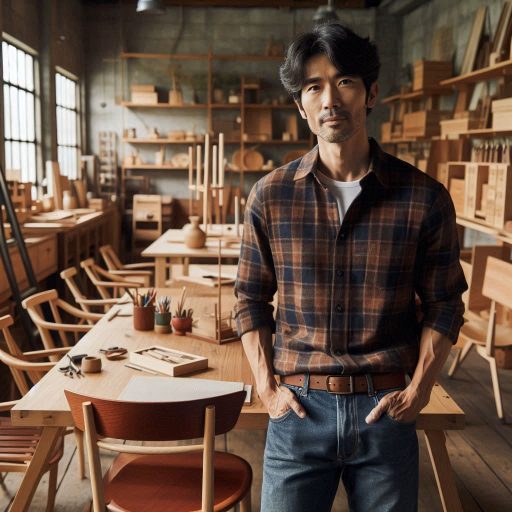Introduction
Eco-friendly materials play a vital role in modern furniture design.
Designers increasingly prioritize sustainability in their projects.
Eco-friendly materials minimize environmental harm while maintaining aesthetic appeal and functionality.
The shift toward these materials reflects a growing awareness of our ecological responsibilities.
Using sustainable materials in furniture design significantly impacts the environment.
The furniture industry is notorious for its resource-intensive processes.
Traditional materials often contribute to deforestation, pollution, and waste.
In contrast, eco-friendly options reduce these negative effects.
They promote a circular economy, where resources are reused and recycled.
Statistics reveal the alarming environmental impact of traditional furniture materials.
For instance, the production of conventional wood furniture contributes to deforestation.
According to the World Wildlife Fund, approximately 18 million acres of forest are lost each year.
This loss threatens biodiversity and contributes to climate change.
Moreover, many traditional materials require harmful chemicals during production.
A study by the U.S.A. Environmental Protection Agency highlights that furniture finishes release volatile organic compounds (VOCs).
These compounds can harm indoor air quality and pose health risks.
In fact, some VOCs are known carcinogens.
Using eco-friendly materials also supports healthier living spaces.
Furniture made from sustainable materials often lacks harmful chemicals.
This leads to improved indoor air quality and promotes overall well-being.
Consumers increasingly seek products that enhance their health and reduce environmental harm.
Types of Eco-Friendly Materials
As sustainability becomes a priority, furniture designers increasingly embrace eco-friendly materials.
These materials not only reduce environmental impact but also offer durability and aesthetic appeal.
Here, we explore some popular eco-friendly options in furniture design.
Various Eco-Friendly Materials Commonly Used in Furniture Design
Bamboo stands out as a highly sustainable material.
It grows rapidly and requires minimal water and pesticides.
Bamboo‘s natural strength makes it incredibly durable, often outperforming traditional hardwoods.
Its unique grain patterns add a modern touch to furniture, making it both stylish and eco-friendly.
Reclaimed wood serves as another excellent choice.
Designers source reclaimed wood from old buildings, pallets, and furniture.
This process reduces deforestation and landfill waste.
Reclaimed wood boasts rich textures and histories that add character to any piece.
Each item crafted from reclaimed wood tells a unique story, enhancing its aesthetic appeal.
Recycled plastic has gained traction in furniture design, especially for outdoor settings.
Manufacturers create recycled plastic from post-consumer waste, such as bottles and containers.
This innovative approach prevents plastic waste from polluting the environment.
Recycled plastic furniture resists weathering and fading, ensuring long-lasting durability.
Additionally, it can mimic the appearance of wood, providing a versatile design option.
Cork is another eco-friendly material that deserves attention.
Harvested from the bark of cork oak trees, it regenerates without harming the tree.
Cork‘s lightweight nature makes it easy to work with, while its unique texture provides a warm aesthetic.
This material is naturally resistant to moisture and mold, making it ideal for various furniture applications.
Include Examples Such as Bamboo, Reclaimed Wood, Recycled Plastic, and Cork
Comparing these eco-friendly materials to traditional options reveals their advantages.
While hardwoods can take decades to mature, bamboo and cork offer rapid growth cycles.
This characteristic significantly reduces the strain on natural resources.
Additionally, reclaimed wood provides an opportunity to utilize existing materials, decreasing the need for new timber.
Moreover, eco-friendly materials often showcase better durability.
For instance, recycled plastic withstands harsh weather conditions without cracking or fading.
In contrast, traditional materials may require more maintenance and replacements over time.
The Durability and Aesthetic Appeal of These Materials Compared to Traditional Options
The aesthetic appeal of eco-friendly materials also rivals that of conventional options.
Designers incorporate unique colors and textures, enhancing the visual appeal of furniture.
The use of bamboo, reclaimed wood, recycled plastic, and cork allows for creative expression while promoting sustainability.
In short, eco-friendly materials are transforming furniture design.
With options like bamboo, reclaimed wood, recycled plastic, and cork, designers create durable and visually appealing pieces.
By choosing these materials, consumers can enjoy beautiful furniture while supporting a sustainable future.
Embracing eco-friendly materials is a step toward responsible design that benefits both people and the planet.
Read: Visual Merchandising: Best Practices for Beginners
Benefits of Using Eco-Friendly Materials
Eco-friendly materials significantly benefit both the environment and human health.
Choosing sustainable materials in furniture design promotes a healthier planet.
Designers play a vital role in reducing ecological harm by opting for these materials.
Each piece of eco-friendly furniture contributes to a greener future.
The Environmental Benefits of Using Sustainable Materials in Furniture Design
Sustainable materials, such as bamboo, reclaimed wood, and organic cotton, reduce the carbon footprint.
These materials require less energy to produce compared to traditional options.
For instance, bamboo grows quickly, requiring minimal resources.
Reclaimed wood repurposes existing materials, avoiding the need for new trees.
This approach helps preserve forests and reduces deforestation.
Additionally, eco-friendly materials minimize waste generation during production.
Many sustainable materials come from renewable sources, meaning they can be replenished.
Using recycled materials further decreases waste in landfills.
Designers can craft beautiful furniture while actively combating waste issues.
Each eco-friendly choice reflects a commitment to sustainability.
How These Materials Help Reduce Carbon Footprint and Waste
Sustainable materials significantly lower carbon emissions throughout their lifecycle.
The production process of eco-friendly materials often requires less energy.
This energy efficiency directly reduces greenhouse gas emissions.
By decreasing reliance on fossil fuels, designers contribute to a healthier planet.
Reclaimed materials play a crucial role in waste reduction.
Using existing wood prevents additional trees from being cut down.
This practice not only conserves resources but also helps maintain biodiversity.
Every eco-friendly furniture piece represents a step toward sustainability.
The Health Benefits Associated with Eco-Friendly Furniture Materials
Health benefits also arise from using eco-friendly furniture materials.
Traditional materials often contain harmful chemicals and toxins.
These substances can negatively impact indoor air quality.
By contrast, sustainable materials typically avoid harmful additives.
Organic textiles, for example, use natural dyes and processes.
This creates a healthier living environment for consumers.
Moreover, eco-friendly materials can contribute to overall well-being.
Studies indicate that natural materials promote comfort and relaxation.
People often feel more at ease in spaces designed with sustainable elements.
Using wood, for instance, can create a calming atmosphere in homes.
These emotional benefits enhance the quality of life.
Investing in eco-friendly furniture can also lead to financial savings.
Sustainable materials often prove durable and long-lasting.
High-quality eco-friendly furniture stands the test of time, reducing the need for replacements.
This longevity benefits both consumers and the environment.
Furthermore, consumers increasingly seek eco-friendly options.
They appreciate businesses that prioritize sustainability.
Furniture designers can tap into this growing market by using eco-friendly materials.
By doing so, they can attract environmentally conscious customers.
Most importantly, the benefits of using eco-friendly materials in furniture design are numerous.
They contribute to environmental preservation, reduce carbon footprints, and minimize waste.
Health benefits associated with these materials further enhance their appeal.
By choosing sustainable materials, designers promote a healthier planet and a better quality of life for consumers.
Embracing eco-friendly options reflects a commitment to a sustainable future.
Read: Visual Merchandiser: Job Market and Opportunities
Design Trends in Eco-Friendly Furniture
The furniture design landscape is rapidly evolving toward sustainability.
Designers increasingly focus on eco-friendly materials to meet consumer demand.
This shift reflects a broader movement toward environmental consciousness.
As a result, eco-friendly furniture is gaining popularity in modern homes and businesses.
Analyze Current Design Trends in Eco-Friendly Furniture
Minimalism remains a dominant trend in eco-friendly furniture design.
This approach emphasizes simplicity, functionality, and beauty.
Minimalist designs utilize clean lines and uncluttered spaces.
They also prioritize high-quality materials that are both sustainable and durable.
Many consumers prefer furniture that serves multiple purposes, enhancing space efficiency.
These multifunctional pieces appeal to those seeking minimalism without sacrificing utility.
Sustainable furniture materials are becoming essential in contemporary design.
Designers are exploring natural materials such as reclaimed wood, bamboo, and cork.
Reclaimed wood, sourced from old buildings or furniture, reduces waste and promotes a circular economy.
Bamboo grows rapidly and absorbs carbon dioxide, making it an eco-friendly alternative.
Cork, harvested from tree bark, is renewable and provides unique texture.
The Growing Popularity of Minimalist and Sustainable Furniture Designs
In addition to traditional materials, designers innovate by incorporating recycled and upcycled elements.
They transform waste into beautiful, functional pieces.
For example, recycled plastics are molded into stylish furniture that reduces landfill waste.
Upcycling old furniture gives new life to discarded items while preserving their history.
This creativity resonates with eco-conscious consumers who appreciate unique, handcrafted designs.
Textiles also play a vital role in eco-friendly furniture trends.
Designers increasingly opt for organic fabrics made from hemp, linen, or cotton.
These materials avoid harmful chemicals and promote sustainable farming practices.
Additionally, many brands focus on using low-impact dyes and processes.
This commitment to sustainability extends beyond the furniture itself, influencing the entire production chain.
How Designers Are Incorporating Eco-Friendly Materials in Innovative Ways
The rise of biophilic design reflects the growing desire to connect with nature.
Designers incorporate natural elements into their creations, blurring the line between indoor and outdoor spaces.
This approach often involves using live plants or plant-inspired patterns.
Biophilic designs create a calming environment and improve well-being.
They highlight the importance of nature in our daily lives.
The popularity of eco-friendly furniture will only continue to rise.
Consumers are more informed about environmental issues than ever before.
They seek products that align with their values.
Designers must adapt to this demand, pushing the boundaries of creativity and sustainability.
By prioritizing eco-friendly materials and innovative designs, they contribute to a more sustainable future.
Essentially, eco-friendly furniture trends reflect a growing awareness of environmental issues.
Minimalism, sustainable materials, and innovative designs are at the forefront.
As consumers demand more eco-friendly options, designers will continue to lead the way.
Read: Essential Skills for Aspiring Costume Designers

Challenges of Using Eco-Friendly Materials
Designing furniture with eco-friendly materials presents unique challenges for designers and manufacturers.
While sustainability is a noble goal, various obstacles can hinder the process.
Understanding these challenges is crucial for creating beautiful, environmentally responsible pieces.
Address the Challenges Faced by Designers and Manufacturers When Working with Sustainable Materials
One major challenge is the cost of eco-friendly materials.
Sustainable options often come at a premium compared to conventional materials.
For instance, reclaimed wood and organic textiles may have higher price tags.
This added cost can strain budgets, particularly for small businesses or startups.
Designers must find ways to balance sustainability with affordability to remain competitive.
Sourcing eco-friendly materials can also prove difficult.
Reliable suppliers of sustainable materials may be scarce, depending on location.
For example, bamboo and cork might not be readily available in all regions.
This limited availability can delay production timelines and complicate the design process.
Designers need to research and build relationships with trusted suppliers to ensure consistent access to these materials.
Additionally, the properties of eco-friendly materials can pose challenges.
Some sustainable options may not perform as well as traditional materials.
For instance, biodegradable plastics might lack durability compared to standard plastics.
Designers must adapt their techniques and methods to account for these differences.
This often requires extensive testing and experimentation to achieve desired results.
Talk About the Cost Implications and Sourcing Difficulties Associated with Eco-Friendly Materials
The financial implications of using eco-friendly materials are significant.
Designers often face budget constraints when opting for sustainable materials.
Higher costs can limit choices and force compromises in design.
Additionally, shipping expenses for specialty materials can add to overall project costs.
These financial hurdles can discourage the use of eco-friendly options.
Sourcing sustainable materials poses its own challenges.
Limited availability can disrupt production timelines.
Designers may find it difficult to locate suppliers who offer consistent quality and fair pricing.
This scarcity can also lead to increased competition among designers for the same materials.
Effective sourcing requires research and networking to identify reliable partners.
Solutions and Tips for Overcoming These Challenges in Furniture Design
To overcome these challenges, designers can implement several strategies.
First, they should conduct thorough research on sustainable materials.
Understanding the benefits and limitations of each option allows for informed decisions.
This knowledge will aid in selecting materials that align with design goals and budgets.
Building relationships with suppliers is also essential.
Establishing connections can lead to better pricing, reliable sourcing, and potential collaboration opportunities.
Designers can negotiate bulk orders or explore local sourcing options to reduce costs and environmental impact.
Networking with other designers can provide valuable insights.
Joining professional organizations or online communities can help designers share experiences and best practices.
Learning from others can spark new ideas and solutions for common challenges.
Finally, designers can educate clients about the benefits of eco-friendly materials.
Many consumers are willing to invest more for sustainable options if they understand the long-term advantages.
By communicating these benefits, designers can justify higher costs and foster appreciation for sustainable practices.
In a nutshell, while challenges exist in using eco-friendly materials in furniture design, proactive strategies can mitigate these issues.
By researching, networking, and educating, designers can create sustainable, high-quality pieces that meet both environmental and aesthetic standards.
Embracing these challenges can lead to innovative solutions and a brighter, more sustainable future in furniture design.
Transform Your Career Today
Unlock a personalized career strategy that drives real results. Get tailored advice and a roadmap designed just for you.
Start NowRead: Famous Costume Designers in Hollywood
Find Out More: Innovative Trends in Creative Direction 2024
Gain More Insights: Web Design Internships: What You Need to Know
Case Studies of Eco-Friendly Furniture Brands
Eco-friendly furniture brands lead the way in sustainable design.
They prioritize materials, craftsmanship, and environmental responsibility.
Let‘s explore five successful brands that specialize in eco-friendly furniture.
Successful Furniture Brands That Specialize in Eco-Friendly Materials
West Elm
West Elm embraces sustainable sourcing and ethical production.
They offer a range of furniture made from reclaimed wood.
Their design philosophy focuses on modern aesthetics combined with traditional craftsmanship.
Popular pieces include the Reclaimed Wood Dining Table and the Mid-Century Modern Sofa, which use responsibly sourced materials.
West Elm also partners with artisans worldwide, ensuring fair wages and community support.
IKEA
IKEA commits to sustainability through innovative materials and practices.
They aim to use renewable or recycled materials in their products.
The brand emphasizes affordability and accessibility without sacrificing quality.
Their popular KUNGSBACKA kitchen fronts, made from recycled PET plastic, exemplify this commitment.
IKEA also encourages customers to return used furniture for recycling, promoting a circular economy.
Thuma
Thuma specializes in sustainable bedroom furniture.
Their platform bed uses reclaimed wood, offering a unique, rustic charm.
Thuma‘s design philosophy centers around simplicity and functionality.
Each piece is designed for easy assembly and disassembly.
The brand focuses on minimizing waste, using eco-friendly packaging, and sourcing materials responsibly.
Their popular bed frames are both stylish and sustainable.
Gus* Modern
Gus* Modern combines contemporary design with eco-conscious materials.
They use responsibly sourced wood, recycled steel, and low-VOC finishes in their products.
The brand’s philosophy highlights clean lines and functional design.
Their popular collection includes the Alda Sofa, crafted with FSC-certified wood and environmentally friendly fabrics.
Gus* Modern actively seeks ways to reduce their environmental footprint while creating timeless designs.
Loll Designs
Loll Designs transforms recycled materials into stylish outdoor furniture.
The brand focuses on sustainability through innovative design and durable materials.
They use recycled high-density polyethylene (HDPE) plastic, which is weather-resistant and long-lasting.
Their design philosophy emphasizes playful aesthetics and functionality.
Popular pieces include the Loll Adirondack Chair, which combines comfort with eco-friendliness.
Loll Designs actively participates in environmental initiatives, supporting reforestation efforts and community projects.
Their Design Philosophies, Material Choices, and Sustainability Practices
These five brands exemplify the successful integration of eco-friendly materials in furniture design.
They showcase how thoughtful design, responsible sourcing, and sustainable practices can coexist.
Examples of Popular Eco-Friendly Furniture Pieces From These Brands
By choosing brands that prioritize the planet, consumers can make informed choices that benefit both their homes and the environment.
Embracing eco-friendly furniture contributes to a more sustainable future.
DIY Eco-Friendly Furniture Projects
Creating eco-friendly furniture can be both fun and fulfilling.
With a few recycled materials or sustainable alternatives, you can craft unique pieces for your home.
Here are some easy DIY projects to inspire your creativity.
Inspiration for Readers to Create Their Own Eco-Friendly Furniture Pieces
The world of DIY eco-friendly furniture is full of possibilities.
You can transform discarded materials into beautiful, functional pieces.
Each project not only reduces waste but also adds a personal touch to your home.
Embrace creativity and explore how simple items can become stunning furniture.
Easy DIY Projects Using Recycled Materials or Sustainable Alternatives
Reclaimed Wood Coffee Table
Materials Needed:
- Reclaimed wood planks
- Sandpaper
- Wood glue
- Screws
- Stain or sealant (optional)
Instructions
- Collect reclaimed wood planks from old furniture or pallets.
- Sand the planks until smooth. Remove any rough edges.
- Lay out the planks to create the tabletop.
- Use wood glue to attach the planks together.
- Reinforce with screws underneath the tabletop.
- If desired, stain or seal the wood for protection.
- Enjoy your rustic coffee table!
Upcycled Crate Shelving
Materials Needed
- Wooden crates (or wine boxes)
- Sandpaper
- Paint or stain (optional)
- L-brackets
Instructions:
- Gather wooden crates from local stores or friends.
- Sand the crates to remove splinters.
- Paint or stain the crates to match your decor.
- Decide on the arrangement for your shelving.
- Secure the crates to the wall using L-brackets.
- Arrange your favorite books or decor on the shelves.
Pallet Bench
Materials Needed
- Wooden pallets
- Sandpaper
- Outdoor paint or sealant (if used outdoors)
- Cushions (for comfort)
Instructions
- Find wooden pallets from local stores or online marketplaces.
- Sand the pallets thoroughly to smooth the surfaces.
- Stack two pallets for the bench’s base.
- Optionally, paint or seal the pallets to protect them.
- Add cushions on top for comfort.
- Place the bench in your favorite outdoor spot.
Include Step-by-Step Instructions and Tips for Sourcing Materials
- Check Local Stores: Visit home improvement stores for discounted or leftover materials.
- Thrift Shops: Explore thrift stores and garage sales for unique finds.
- Community Groups: Join local community groups that share or trade materials.
- Online Marketplaces: Search online platforms for free or cheap reclaimed materials.
These DIY projects not only help reduce waste but also let you express your style.
Start small and experiment with different materials.
You‘ll feel proud knowing you created eco-friendly furniture that enhances your home.
Share your projects with friends and encourage them to join the movement toward sustainable design!
Conclusion
Incorporating eco-friendly materials in furniture design is essential for sustainable living.
Sustainable furniture helps reduce environmental impact and promotes responsible consumption.
Choosing eco-friendly options leads to healthier indoor spaces.
These materials minimize harmful emissions and support better air quality.
Using sustainable materials also fosters a connection to nature.
Furniture made from responsibly sourced wood, recycled metals, and organic fabrics enhances both aesthetic and environmental value.
Consumers increasingly demand sustainable products.
Designers and manufacturers respond by prioritizing eco-friendly practices in their designs.
As you consider your next furniture purchase, think about sustainability.
Evaluate the materials used in the products you choose.
Look for certifications like FSC (Forest Stewardship Council) for wood or GOTS (Global Organic Textile Standard) for textiles.
These certifications indicate responsible sourcing and manufacturing practices.
In addition to checking certifications, research local artisans and manufacturers who prioritize sustainability.
Supporting local businesses reduces carbon footprints and strengthens communities.
When possible, opt for custom pieces made from reclaimed or repurposed materials.
These unique items not only reduce waste but also add character to your space.
[E-Books for Sale]
The Big Book of 500 High-Paying Jobs in America: Unlock Your Earning Potential
$19.99 • 500 High-Paying Jobs • 330 pages
Explore 500 high-paying jobs in America and learn how to boost your career, earn more, and achieve success!
See All 500 High-Paying Jobs of this E-Book
1001 Professions Without a Degree: High-Paying American Jobs You Can Start Now
$19.99 • 1001 Professions Without a Degree • 174 pages
Discover 1001 high-paying jobs without a degree! Unlock career tips, skills, and success strategies for just $19.99!




